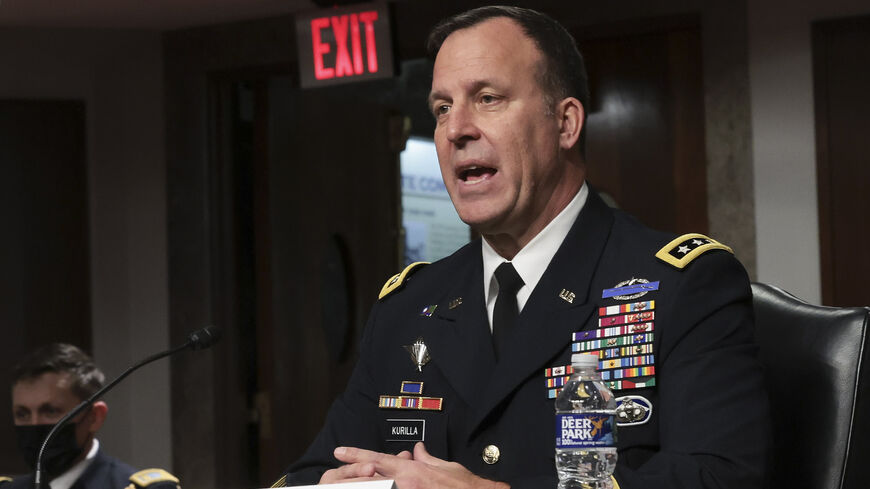In an auditorium-style conference room at US Central Command (CENTCOM) headquarters, the top general overseeing all American military forces in the Middle East was beaming.
Flanked by executives from Microsoft, Google and Blue Origin, US Army Gen. Michael “Erik” Kurilla had just been presented with the best idea he had heard in long time — by a buck sergeant still in his 20s.
Sgt. Mickey Reeve of the Massachusetts Army National Guard had coded his own computer program, a simulator to train soldiers to respond to incoming drone attacks, using only an aging laptop during downtime in his bunk at Prince Sultan air base in Saudi Arabia over the prior two months.
“Unmanned aircraft systems have been called the most dangerous threat to American soldiers since IEDs,” Reeve pitched to his hosts at the October event.
“This will allow us to train our battle drills, because that’s what we can’t do right now [while deployed in the field]," he explained. “Without that, we’re not going to be capable of engaging these drones effectively … when there are just minutes to save American lives.”
Kurilla was thrilled. “This is a significant problem,” the four-star general told the audience. “There’s a real need for this.”
What's more, Reeve estimated a team of no more than five developers could ready the simulator for military-wide distribution within six months.
“That’s lightning-fast in the military,” Kurilla boomed. “That’s like, tomorrow.”
The general and his guests from Silicon Valley chose the 24-year-old sergeant’s idea over some 160 other submissions to CENTCOM’s first “Innovation Oasis,” a semi-annual command-wide contest of ideas modeled after the popular TV show “Shark Tank.”
Development of the simulator remains on schedule to be completed within 90 days, thanks to support from Army Futures Command's Software Factory, CENTCOM's Chief Technology Officer Schuyler Moore told reporters at the Pentagon on Dec. 7.
Military officials plan to ready the training program for upcoming multinational exercises of Red Sands, a new CENTCOM-led consortium to test counter-drone technology at various sites in the Middle East.
It’s an unconventional — and largely untested — approach aimed at netting ideas from commercial industry, academia and the 55,000 members of CENTCOM’s own rank-and-file as the Pentagon gears up for a new era of military cooperation in the Middle East.
“This is about changing culture,” said Kurilla, a veteran of Joint Special Operations Command (JSOC) who took the helm at CENTCOM in April after leading the XVIII Airborne Corps.
“If you’ve got an E-4 [corporal] that knows how to solve a problem, we want to make sure we can harness that,” Kurilla told Al-Monitor.
And CENTCOM, which oversees the US military’s engagements from Egypt to Central Asia to Pakistan and the Arabian Sea, has its share of problems.
Flush with funds and allocations of military hardware during the prior two decades of counterterrorism wars in Iraq and Afghanistan, CENTCOM's mission of combatting Sunni jihadist groups and deterring Iran’s provocations remains largely unchanged today.
But the region in which Kurilla’s forces operate is no longer the top strategic priority for policymakers in Washington.
The Pentagon has withdrawn thousands of its forces from Afghanistan, Iraq and the Persian Gulf region over the past three years, even as Iran’s clandestine attacks on its neighbors have continued. That, along with new restrictions on US arms sales to the Saudi-led coalition countries, helped drive trust among some US partners in the Middle East to new lows, analysts and former officials say.
Savvy bureaucratic moves by Kurilla’s predecessor, retired Marine Corps Gen. Kenneth “Frank” McKenzie, helped ensure top brass approved his bevy of requests for B-52 bomber fly-overs and aircraft carrier deployments in a high-stakes bid to deter Iranian attacks and reassure allies during the Trump years.
But critics say those tactics — the effectiveness and sustainability of which were controversial even within the Pentagon at the time — created false expectations among leaders in the region who have come to equate the size of the US military's local footprint with Washington’s dedication to its defense partnerships, a perception that Biden administration officials have striven to dispel.
Earlier this month, McKenzie went so far as to admit that over-reliance on conventional shows of force “has failed” to stop attacks by Iran and its proxies.
“The Iranians fully understand overmatch,” said Jonathan Lord, director of the Middle East Security Program at the Center for New American Security.
“Flying strategic bombers in from Minot Air Force base to run routes along Iran’s coast has only served to push Iran further toward asymmetrical solutions and to lean harder into proxies that extend deniability,” Lord said. “It was a conventional solution to an unconventional threat, and proved ineffective.”
Conscious of this, Kurilla and his staff have over the past year drafted a new path forward, one that strives to stitch together the region’s air defenses with Israeli tech to neutralize Tehran’s drone and missile threats, all the while leveraging new congressional authorities to bring in commercially-available, US-made unmanned sensors linked with artificial intelligence to surveil the region’s waterways, skies and desert smuggling routes.
CENTCOM officials hope the approach will convince regional leaders that Washington can still offer better defense solutions than China and Russia by tapping into the Pentagon’s innovation bureaucracy in order to develop new manned-unmanned teaming tactics in the field.
“We’re still structured as a warfighting headquarters, but the experimentation is our comparative advantage — that’s what we offer,” Brig. Gen. John Cogbill, the command’s deputy director of operations, told Al-Monitor in an exclusive interview at CENTCOM’s headquarters during Innovation Oasis.
To that end, CENTCOM staff have been consulting with JSOC, the tech industry and researchers at Vanderbilt, Penn State and other universities to scout new talent and identify devices that can be field-tested in the region by one of CENTCOM’s three new experimental units: the Navy’s Task Force 59, the Air Force’s Task Force 99 and the Army’s Task Force 39.
“It’s really about creating an ecosystem around our problems so you can leverage non-DOD resources and capabilities in order to help us do our mission better,” Cogbill said.
Deterrence by detection
Despite run-ins with Iranian naval ships in August and September last year, US Navy officials insist the surveillance methods spearheaded by TF 59 are already beginning to have an effect.
“We knew that we were making them nervous,” Moore told Al-Monitor, declining to cite specific incidents.
The Navy stood up TF 59 in September 2021 after Fifth Fleet commander Vice Adm. Brad Cooper recommended to McKenzie that the fleet turn to the private sector to help plug gaps in coalition patrols in waters traversed by smugglers, some backed by Iran.
Within a month, the new unit had begun deploying unmanned, unarmed, camera-laden sea drones linked by artificial intelligence into the Persian Gulf.
“That’s unheard-of speed for the Defense Department,” stressed Moore, previously TF 59’s chief tech officer.
TF 59 has since conducted exercises with Bahrain, Jordan, Kuwait, Qatar, Saudi Arabia and Israel, and has deployed some two dozen drones — among them Saildrones, MARTAC Mantas T12s, T38 Devil Rays — with the goal that regional navies will contribute 80 such devices by the end of 2023.
Only Bahrain and Kuwait have signaled intent to obtain US-made sea drones, Cooper told reporters in October, however, expressing confidence that other countries would follow suit. TF 59 has already tested the drones’ mesh network link with Israel, Jordan and Saudi Arabia.
“If you’re more dependent on partners, you have to be interoperable. On the modern battlefield, that means you have to be able to pass data. Because that’s what we’re trying to get at, is data-centric war-fighting,” Cogbill told Al-Monitor.
“How do you come up with cross-domain solutions when there’s no regional Five Eyes [intelligence alliance], and some of these countries don’t necessarily trust each other?” he added.
It’s a problem that has dogged CENTCOM planners for more than a decade, and one on which Kurilla and his staff are determined to make strides. “At the end of the day, the only way... is with exercises,” Cogbill said.
While officials say the deterrence-by-surveillance approach is not a panacea to disrupting Iran's covert activities, it has earned the increasing approval of strategists in Washington.
Throughout this past year, the White House's National Security Council spearheaded the declassification of intelligence about Russia’s war plans in Ukraine in a groundbreaking attempt to thwart the Kremlin’s moves. Policymakers have since applied the tactic to Iran’s transfer of hundreds of armed drones to Russia for use in the war.
Earlier this month, the Pentagon’s No. 3 top official Colin Kahl credited the leak of intelligence detailing Iranian plans to attack Saudi Arabia with averting that incident.
“The IRGC prefers to operate with plausible deniability,” Jonathan Lord told Al-Monitor, referring to Iran's Islamic Revolutionary Guard Corps.
“Task Force 59 is about developing relatively low-cost and operationally sustainable ways to turn the sensitive waterways around the Gulf into a panopticon, robbing Tehran of the ability to threaten commercial shipping or to smuggle weapons with impunity,” Lord said.
Navy officials have been reluctant to credit TF 59 with last year’s surge in drug and arms seizures, but CENTCOM has already stood up two additional task forces to replicate TF 59’s acquisitions and testing model.
“For pennies on the dollar, we can put unmanned platforms out there, we can couple it with artificial intelligence, and we can really get a sense for what’s happening,” Cooper told reporters during a visit to the Pentagon in October.
“The end result of that is you simply can advance your capability on orders of magnitude faster by this close connection with industry,” he said.
The Air Force's TF 99, established in October at al-Udeid air base in Qatar, aims to test commercially-available small, high-altitude drones linked by the same mesh network used by — and eventually Starlink systems — TF 59 in order to compensate for fewer US ISR assets in the region.
By November, the Army had tapped Col. Adontis Atkins, chief of operations at US Cyber Command, to lead its TF 39. Defense officials say the newest unit, based out of Shaw Air Force base in North Carolina, will experiment with unmanned ground vehicles, remote sensors and weapons that can disable small drones (C-sUAS) at bases throughout the Middle East.
Thus far, TF 59 has overseen the testing of unclassified, contractor-owned and -operated technology, which defense officials see as a model to be emulated by TF 99 and TF 39 over the coming year. The aim is to eventually synchronize the task forces and fully integrate the data they gather.
But will it be enough to sell Arab allies and partners on the superiority of US and Israeli tech?
All eyes will be on the first iteration of Red Sands, to be held early this year in Saudi Arabia. Alongside accelerated multinational exercises, the testing program is poised to become CENTCOM’s flagship forum for building confidence in its vision for a new regional security architecture.
“You can start to see how Gen. Kurilla is playing matchmaker,” Lord said. “He is setting the conditions for that and building a market.”







